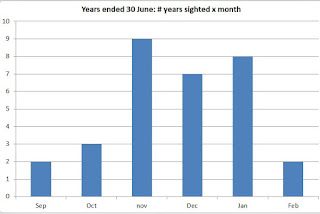I've also posted a few other items as the month evolved:
- White-winged Trillers earned a special post by being very evident this year;
- With hot dry weather a lot of birds visited our bird bath for a drink or a splash.
- A juvenile Pallid Cuckoo was eventually identified.
Water birds have been rather sparse this season with attractive floods in Victoria, However, with 8 species recorded, raptors have made a better showing than recent months. The presence of 6 Brown Falcons on the Plain is notable.
The least common bird seen this month was Red-capped Robin with 2 birds seen on the Plain. They have more usually been seen in November or December and this sighting might mean they bred in the area but this isn't proven. (There have been several reports of breeding in the ACT this season). The other exciting breeding reports have been the success of the Banded Lapwings on the Plain. The two chicks are now almost full grown and the flock is now up to 7 birds.
Most Summer migrants were still around in January, but some species will soon start moving off. If we get any storms appear the chances of spotting Swifts will increase over the next couple of months
Breeding is, as expected, beginning to wind down. 15 species were observed breeding this month
As always, thanks to the observers who have provided reports to me for the month. These have covered sites in Whiskers Creek Rd, Widgiewa Rd, Knox Close, Wanna Wanna Rd, the Molonglo Valley and Hoskinstown Village and Plain. Please pass on interesting sightings to me by email to martinflab@gmail.com.
1 Waterbirds (pt 1): (pt 2); (Pt 3); (Pt 4): Black Swan; Australian Wood Duck; Pink-eared Duck; Grey Teal; Pacific Black Duck; Hardhead; Australasian Grebe; Hoary-headed Grebe; Little Black Cormorant; Little Pied Cormorant; Great Cormorant;White‑necked Heron; White‑faced Heron;Australian White Ibis; Eurasian Coot; Masked Lapwing; Banded Lapwing;
2 Birds of Prey: Black-shouldered Kite; Brown Goshawk; Collared Sparrowhawk; Wedge-tailed Eagle; Little Eagle; Nankeen Kestrel; Brown Falcon; Peregrine Falcon.
3 Parrots and Relatives: Yellow-tailed Black-Cockatoo; Gang‑gang Cockatoo; Galah; Little Corella; Sulphur‑crested Cockatoo; Australian King‑parrot; Superb Parrot; Crimson Rosella; Eastern Rosella; Red-rumped Parrot
4 Kingfishers and other non-songbirds (Pt 1) (Pt 2) (Pt 3): Stubble Quail; ; Common Bronzewing; Crested Pigeon; Tawny Frogmouth; Horsfield's Bronze‑Cuckoo; Shining Bronze‑cuckoo; Pallid Cuckoo; Brush Cuckoo; Southern Boobook; Laughing Kookaburra; Sacred Kingfisher; Dollarbird
5 Honeyeaters: Eastern Spinebill; Yellow-faced Honeyeater; White-eared Honeyeater; Noisy Miner; Red Wattlebird; Brown‑headed Honeyeater; Noisy Friarbird;
6 Flycatchers and similar species: Rufous Whistler; Grey Shrike-thrush; Grey Fantail; Willie Wagtail; Leaden Flycatcher; Magpie-lark; Scarlet Robin; Red‑capped Robin; Welcome Swallow; Fairy Martin; Tree Martin
7 Thornbills, Finches and similar species (Pt 1) (Pt 2): Superb Fairy-wren; White-browed Scrubwren; Weebill; White-throated Gerygone; Striated Thornbill; Yellow‑rumped Thornbill; Buff‑rumped Thornbill; Brown Thornbill; Spotted Pardalote; Striated Pardalote; Silvereye; Red‑browed Finch; Diamond Firetail; House Sparrow; European Goldfinch
8 Other, smaller birds: White-throated Treecreeper; Varied Sitella; Black-faced Cuckoo-shrike; White‑-winged Triller; Olive‑backed Oriole; Dusky Woodswallow; Skylark; Australian Reed-warbler; Rufous Songlark; Brown Songlark; Common Blackbird; Common Myna; Common Starling; Mistletoebird; Australasian Pipit;
9 Other, larger birds: Satin Bowerbird; Grey Butcherbird; Australian Magpie; Pied Currawong; Grey Currawong; Australian Raven; Little Raven; White-winged Chough

























